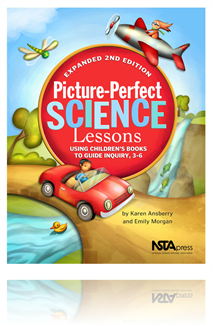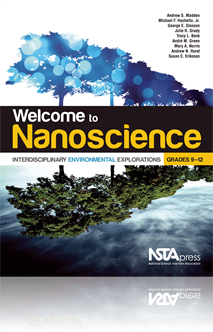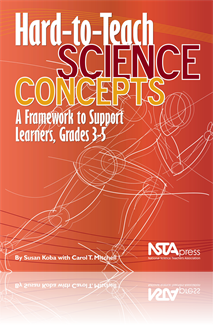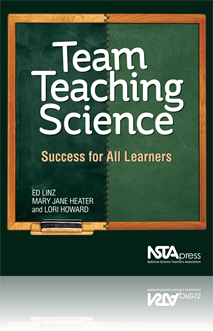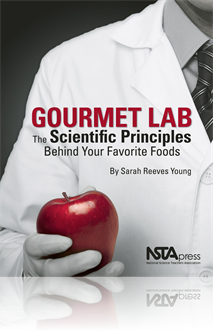All Book Chapters
Book Chapter
Learners explore how sound is produced by vibrations. They make a straw instrument and investigate how to vary its pitch. Learns also design and build an instrument that produces a high pitch and a low pitch and explain how it works. For more inform...
Book Chapter
Learners explore the differences between chemical and physical changes by observing a variety of changes in mater. Learners observe the chemical change of cooking pancakes and identify new menu items for the Chemical Change Café. For more informati...
Book Chapter
In this chapter, you will learn how experiments are structured. This structure or experimental setup is called the research design. The research design of an experiment determines both whether the experiment is likely to succeed and the reliability ...
Book Chapter
Close Encounters of the Symbiotic Kind
Learners explore how some organisms interact with other organisms through symbiotic relationships by observing “mystery objects” (plant galls) collected from the local ecosystem. For more information on how to implement Picture-Perfect Science in...
Book Chapter
By taking part in a simulation, learners explore the many threats to sea turtles and the ways humans can help them survive. Learns identify which dangers result from human actions and which dangers are natural. Learners also explore the life cycles o...
Book Chapter
Learners explore the importance of rice as a food source, the differences among types of rice, the life cycle of rice, and rice production methods. Learners also explore control, variables, and experimental design by investigation how rice grows and ...
Book Chapter
Nano2Earth Curriculum and the National Science Education Standards
With the Nano2Earth curriculum, students learn about nanotechnology and nanoscience by using inquiry to study groundwater pollution. The curriculum is designed to meet the National Science Education Standards (NSES) for content in grades 9–12 (NRC ...
Book Chapter
What Are Nanoscience and Nanotechnology? A Nano Primer
In the examples presented in this chapter, the authors have defined the nanoscale and nanoscience. They have seen surprising results for two “ordinary” phenomena that they thought they knew everything about, but which were both shown to have su...
Book Chapter
Historical and Societal Aspects of Nanoscale Science and Technology
The nanorevolution is here to stay. It is this small scale—where we have the ability to put molecules and atoms to new uses—that fuels the hope and hype surrounding nanotechnology. This chapter discuses the origins of nanoscience, nanotechnology ...
Book Chapter
Introduction to Water Pollution
This lesson assesses students’ prior knowledge about groundwater pollution and has students investigate types and sources of water pollution. Note that this introductory activity sets the stage for subsequent learning about sources of water polluti...
Book Chapter
Nanoscale science and technology play central roles in our understanding of how Earth works and in the environmental science field of study. As a freshwater source, groundwater is second in abundance only to water found in glaciers and polar ice. Gro...
Book Chapter
In this lesson, students study the reduction of iron oxide minerals in a simulated anaerobic aquatic environment. Students discuss how the respiration of anaerobic bacteria may be involved with iron reduction. Students also consider problems related ...
Book Chapter
Investigation of Bacterial Transport in Groundwater
Students, in this lesson, explore the transport of bacteria in groundwater by performing a column experiment in a simulated groundwater environment. Students also investigate a groundwater scenario to learn about the influence of groundwater chemistr...
Book Chapter
Nano2Earth Curriculum Overview
The Nano2Earth curriculum is designed to promote student inquiry and learner centered investigations of microbe-mineral interactions at the nanoscale. This chapter shows how the curriculum is organized into lessons and to use the curriculum....
Book Chapter
Nanoforces in Nature: Using Atomic Force Microscopy to Explore Microbe-Mineral Interactions
This lesson uses computer simulations of an atomic force microscope to investigate bacteria-mineral forces of interaction on the order of nanonewtons over nanoscale distances of interaction. In this lesson, students • learn about the atomic force...
Book Chapter
It is not difficult to think of reasons why it is important for students to understand that a round globe represents our planet. After all, Earth is our home in space. Environmentalists remind us that it’s the only home we have, so it’s importa...
Book Chapter
This chapter from, Companion Classroom Activities for Stop Faking It! Force and Motion is about motion. Activities include Time to Roll, Describing Motion, Different Speeds, and Evaluation. ...
Book Chapter
This chapter from, Companion Classroom Activities for Stop Faking It! Force and Motion is about Newton’s Third Law. Activities include Push Back, Newton’s Third Law, Exploding Canisters and Evaluation. ...
Book Chapter
This chapter from, Companion Classroom Activities for Stop Faking It! Force and Motion is about adding directions and vectors. Activities include Direction Matters and Vector Application....
Book Chapter
This chapter from, Companion Classroom Activities for Stop Faking It! Force and Motion is about Newton’s First Law. Activities include Objects at Rest and Staying at Rest. ...
Book Chapter
This chapter from, Companion Classroom Activities for Stop Faking It! Force and Motion is about Newton’s First Law. Activities include Objects in Motion, Galileo Explains It All, Sheep in a Jeep, With Coinage, and Evaluation. ...
Book Chapter
This chapter from, Companion Classroom Activities for Stop Faking It! Force and Motion is about forces. Activities include Changes in Motion and What Causes Them and Evaluation....
Book Chapter
This chapter from, Companion Classroom Activities for Stop Faking It! Force and Motion is about Newton’s Second Law. Activities include How Are These Things Related?, Newton’s Second Bit of Advice for All of Us, Second Law Balloons, and Evaluat...
Book Chapter
This chapter from, Companion Classroom Activities for Stop Faking It! Force and Motion is about gravity. Activities include Gravity on a Roll, Gravity—An Equal Opportunity Force, and Falling Pieces of Metal....
Book Chapter
This chapter from, Companion Classroom Activities for Stop Faking It! Force and Motion is about mass and weight. The activity in this chapter is Mass and Weight....
Book Chapter
This chapter from, Companion Classroom Activities for Stop Faking It! Force and Motion is about acceleration. Activities includes, Changing Motion, Accelerating, Acceleration or Not, and Evaluation. This free selection also includes the Table of Con...
Book Chapter
Introduction to Nanotechnology
Imagining differences in scale can be very easy (a softball is bigger than a baseball) or very difficult (how can we imagine the size of a galaxy?). It is perhaps most challenging to build conceptual frameworks for objects that are too small to see. ...
Book Chapter
Team Teaching Science at the High School Level
The focus of this chapter is the specific challenges of team teaching each individual discipline in the typical high school or secondary school. Although science curricula vary not only from state to state, but even district to district, there is gen...
Book Chapter
Butter Battle: Physical Changes Versus Chemical Changes
When passing hot rolls around the dinner table, buying popcorn at a movie theater, or making cookies, it is there: butter. Creating butter in a bottle helps students see how a physical change can be more drastic than an ice cube melting. This experi...
Book Chapter
Cinnamon Rolls: Creating a Control Set to Analyze the Role of Yeast in Baked Goods
Have you ever taken part in a food fight? There are foods flying left and right, and all you can think about is how you don’t want to get mustard on your new shirt. But instead of worrying about stains, you really should be thinking about density...
Book Chapter
Growing a Pancake: How Environmental Factors Impact Fungi Growth in a Sourdough Starter
Many people spend time cultivating and tending gardens that grow items such as tomatoes, herbs, strawberries, and other produce. But how many people do you know who can grow pancakes? This experiment is all about growing pancakes, or at least an i...
Book Chapter
This experiment presents a different approach to using the biological agent of yeast in a liquid format. Rather than using the yeast in a baking procedure, the fermentation process is highlighted as part of the creation of a carbonated beverage. In...
Book Chapter
If your students are ready to take on more responsibility in the lab, then this is the experiment for you. This experiment guides students through the process of creating their own procedure to test a given independent variable. Students are instr...
Book Chapter
This experiment takes a molecular view of sugar formation, introducing the sucrose molecule and how it can be arranged in different formations to create materials with very different qualities. The lab introduces students to the concept that the c...
Book Chapter
This experiment uses the scientific method skills in a guided inquiry of sugar structure for different classes of candy. The lab is structured to help students use their problem-solving skills to create an experiment that relates sugar structure to...
Book Chapter
Exploding Corn: Differences Between Mass and Volume Changes With Popcorn
The average American eats about 52 quarts of popcorn per year. Think about that the next time you sit down for a movie with a big bowl of popcorn. The science behind corn popping is as simple as boiling water. The physical change in popcorn allows st...
Book Chapter
“Melting” Apples: Using a Temperature Graph to Show Phase Changes in Applesauce
Have you heard the old saying “An apple a day keeps the doctor away?” This experiment allows students to study a phase change in a way that is accessible and edible. The experiment models a physical change from solid to liquid through the re...
Book Chapter
Cold Milk: Measuring Energy Transfer in the Creation of Ice Cream
I scream, you scream, we all scream for ice cream! This experiment demonstrates endothermic reactions in a way that creates a learning experience that connects science with the popular dessert ice cream. Students are introduced to the concept of endo...
Book Chapter
Gummy Invertebrates: Changing Independent Variables in Gelatin Recipes
This hands-on experiment allows students to witness a clear phase change from solid to liquid, while learning key vocabulary about variables and implementing the scientific method. The lab focuses on giving students the opportunity to select the i...
Book Chapter
Acidic Milk: Measuring PH changes When Acid is Introduced in Cheese Making
Most people are not quick to associate the word cheese with the word acid. But the process of making cheese actually begins by raising the acidity of a liquid to cause proteins to curdle to make sour milk. That’s right; acid is used to make sour...



